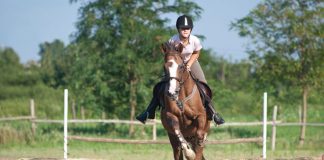 |
| Thoroughbreds coming off the track need a let-down period before the retraining process begins. Photo courtesy New Vocations/horseadoption.com |
Turnout Time
A “let-down period” refers to the time off, whether several weeks or several months, given to an off-the-track-Thoroughbred (OTTB) to alleviate body soreness and let any medications clear from his system.
When you bring your OTTB home, Ford recommends allowing him to get accustomed to turnout time very slowly because he may become more stressed outdoors, running up and down the fenceline and losing weight. “We gradually introduce them to being turned out, then being turned out with another horse, and increasing that turnout time from an hour a day to two hours to four as they become comfortable,” says Ford. “Some take longer than others, and it does affect them mentally and physically if it’s done wrong. We try to keep them comfortable, so if they’re out there pacing the fence, we let them do it for 10 minutes to see if they stop, and then we bring them in.”
Dietary Concerns
As with all horses, the foundation of a good diet is high-quality forage (pasture and/or hay that is free from weeds, dust, mold and other contaminants). Racehorses, however, are fed much more grain than the average show or pleasure horse–sometimes as much as 18 to 20 pounds per day to meet their very high energy requirements. Of course, this is not a practical amount of feed for a horse that lives in a boarding barn and is only trotted around an arena a few times a week.
“The main thing to keep in mind with OTTBs is that they need a lot of calories to keep up their weight,” says Ford. “When they retire, we start them off at 9 pounds of grain per day. For horses needing to gain weight, we will bump it up to 12 pounds per day after a week. They’re normally pretty fit at this point, so if you cut their calories too much, they’re going to lose weight and get skinny.”
Feeding higher-calorie hay, such as one containing alfalfa, will help pack on more pounds with less grain. You can also add corn oil to a commercial grain mix or use a high-fat feed to cut back on the amount of grain. Ford recommends a 12-percent protein grain mix for horses coming off the track.
Read More
Starting Over with Off-the-Track Thoroughbreds Part I
Starting Over with Off-the-Track Thoroughbreds Part II
Slideshow: A Second Chance for Thoroughbreds
For the past nine years, Anna Morgan Ford has served as program director at New Vocations Racehorse Adoption in Marysville, Ohio, with branches in Michigan, Tennessee and Kentucky. The largest such organization in the United States, New Vocations has placed over 3,000 retired Thoroughbred and Standardbred racehorses into adoptive homes. Ford, along with Amber Heintzberger, wrote the informative book “Beyond the Track: Retraining the Thoroughbred from Racehorse to Riding Horse,” released in 2008. www.horseadoption.com






I guess it all depends on the training methods of the TB before you got him and what your plans are with him.